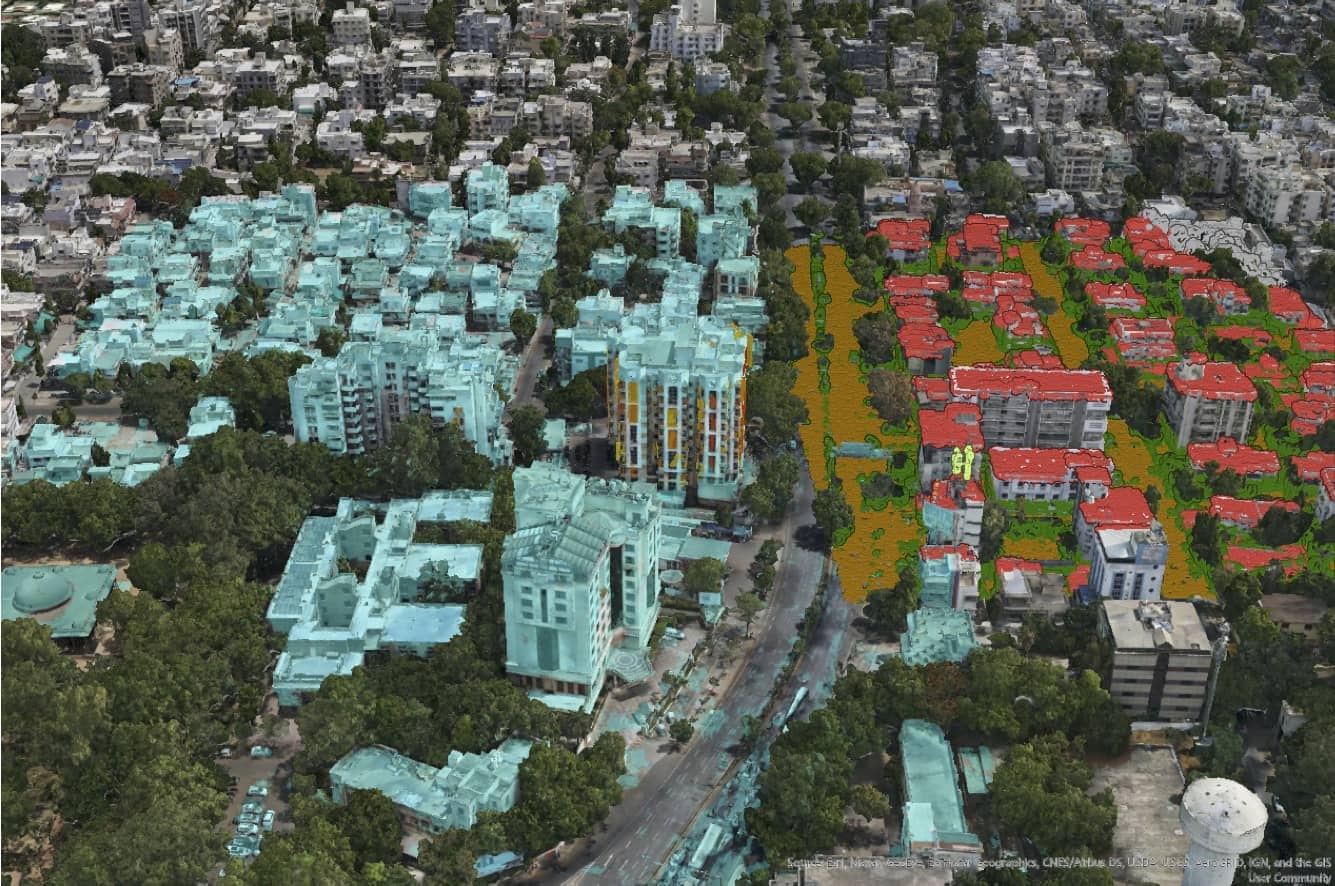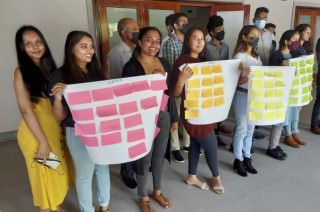
www.buildingsandcities.org/insights/commentaries/cop27-multilateral.html
COP27: Multilateral Approaches are Vital for Urban Climate Actions

By Rajan Rawal (CEPT University)
Cities are the cradle of civilizations and crucial to human endeavour. To ensure long-term resilience, urgent climate change mitigation and adaptation actions by cities need to address both physical and socio-economic planning with specific cultural contexts. The experiences of two Indian cities, Ahmedabad and Chennai, show how local actions can help nations to meet the challenges of development and climate change.
City planners, especially in the Global South, face a dilemma on what to prioritise: meeting developmental goals or climate goals. While some programs may achieve both goals simultaneously, inevitably, a balance often needs to be achieved. Therefore, city planners, leaders and administrators need support from science-based assessments, to develop mitigation, adoption, and resilience strategies for their cities and to take informed decisions for their climate change targets.
In most countries, national governments have developed frameworks or provided overarching guidance for cities to undertake their climate risk assessments, and to develop their climate action plans. One such form of national guidance was the Intended Nationally Determined Contributions (INDC), which are non-binding, national-level propositions underlining climate change mitigation and adaptation. For instance, at COP21 India pledged to reduce its emissions intensity of Gross Domestic Product (GDP) by up to 35% by 2030 below the 2005 level. More recently, India's Nationally Determined Contribution (NDC) increased this commitment to a 45% reduction by 2030.
These frameworks need to be translated into implementable strategies at a city level. To do this requires a substantial amount of capacity at the city level to interpret the guidance, assess local risks and determine city-level targets for mitigation, adoption, resilience and regeneration. It is important that cities have leadership over their targets and the design of their climate action programs, so that they are specific to, and informed by, their local climate, local economy and local socioeconomic structures. Thus, the efficacy of these programs may be enhanced when local governments bring in stakeholders such as civil society organizations (CSOs), and local industry and academic research institutions.
Two cities in India, Ahmedabad and Chennai, have already undertaken this journey and have established climate action plans for their cities. In each case, the city government lead the process and involved local stakeholders to meet their respective, specific challenges.
Ahmedabad
In Ahmedabad, the increasing severity, as well as the frequency of extreme weather events such as heat waves, was a particular challenge needing to be addressed. Specifically, keeping citizens safe during intense heat waves instances during summertime was identified as the highest priority. The Ahmedabad Municipal Corporation (AMC) and its partners first developed the Ahmedabad Heat Action Plan in 2012, and it has been successfully adopted ever since. The AMC repeatedly updates the heat action plan and its implementation strategies based on periodical evaluation of its effectiveness and impact. The objective of the heat action plan is to implement strategies, provide guidance and mandate for better coordination between multiple agencies, as well as to evaluate the efficacy of extreme heat response activities that take place during the heat waves.
The heat action plan adopts four strategies:
- raise public awareness and undertake community outreach. Information regarding the risks and prevention measures gets communicated to the citizens well in advance of extreme events and is issued every year via billboards, news channels, newspapers and social media to reach the most vulnerable people.
- the institutionalisation of an Early Warning System and inter-agency coordination, ensures that extreme temperature forecasts by India Meteorological Department are communicated directly to various local government agencies (e.g. hospitals, electricity, water supply and labour departments) so that they can prepare their guidance, and undertake necessary actions in advance.
- enhance the capacity of healthcare professionals to identify and respond to heat-related sicknesses.
- promote adaptive measures, such as insulating building envelopes and adopting cool roofs.
The roles and responsibilities of each office and government department are articulated in the heat action plan. Pre-summer, during a heat wave, and post-summer, evaluation checklists are an integral part of the document to ensure the city is prepared to respond. The effectiveness of the heat plan and its four strategies was assessed in 2018. The study estimated that there were on average approximately 1,200 fewer deaths annually, after the implementation of the heat action plan (Hess et al. 2018). Based on the learning from Ahmedabad, the heat action plan has now been adopted by other cities, such as Surat, Mumbai, Bhubaneshwar, Nagpur and New Delhi.
Chennai
The city of Chennai in the state of Tamil Nadu (TN) has a different set of local climate action needs to the heat waves of Ahmedabad. Chennai has experienced severe floods, cyclones and drought in recent times. Using the SREX framework of the Intergovernmental Panel on Climate Change (IPCC), Hess et al. (2021) assessed Chennai to be at high risk of extreme events and identified that disaster risk reduction and disaster risk management plans were needed for the city.
Chennai's city administration, local industry, CSOs, local media and research institutions have resolved to act to meet its challenges, and several local programs and projects have been backed by financial institutions and bilateral agencies. One such project focuses on the importance of building occupants' thermal comfort in a high-temperature-high-humidity climate. In 2021 Chennai became the first city in India to implement 'Eco Niwas Samhita' a national residential energy building code for the affordable housing sector. It also amended the Masterplan rules of 1974 to build-in climate resilience into city-wide and sub-city level infrastructure, by passing government orders. As a result, climate change mitigation, adoption, and resilience strategies for buildings are now getting embedded in building planning regulations and building by-laws.
Additionally, a draft Chennai Climate Action Plan has been prepared. This identifies the key threats facing the city and proposes solutions to make Chennai climate resilient. The TN government have also set up a special-purpose vehicle, the Tamil Nadu Green Climate Company (TNGCC) in 2021-22, to develop plans and monitor state-wide climate adaptation and mitigation strategies including the mapping and restoration of sensitive natural habitat. TNGCC is a not-for-profit organization, its board comprise senior civil servants from various departments of the TN Government. The government of TN holds 51% of the equity while the rest is owned by state agencies and statutory organizations such as the TN pollution control board. Although the mandate of the company is to work at the state level, the programs and projects to be carried out by TNGCC will suport city-level activities so will complement programs in the city of Chennai.
Coordinating international, national and local governance
Last year's COP26 resulted in announcements of impressive new goals. However, current climate actions globally fall short of these targets. Thus, the significance of COP27 is to demonstrate the pathways to accomplish the goals though it remains to be seen if COP27 can achieve what COP26 did not, especially as it meets in the backdrop of a volatile geopolitical context.
Ahmedabad and Chennai are examples of how local actions at the city level can help nations meet the challenges of climate change adaptation and mitigation. Keeping the hope for 1.5°C, these two cities demonstrate that by relying on science-based assessment and locally set targets alongside multi-lateral efforts, on the ground action is possible. This gives hope that we can meet these commitments. Crucially, they show the importance of coordinated efforts between the local and national governments. Although climate change is a global issue and requires international agreements and national leadership, local solutions are needed. Therefore, cities need more support to innovate and implement local climate actions, not just so their citizens can survive and thrive but also to ensure global threats of climate change are effectively met.
References
Hess, J.J., Sathish, L.M., Knowlton, K., Shubhayu Saha, S., Dutta, P., … Mavalankar, D. (2018). Building resilience to climate change: pilot evaluation of the impact of India's first heat action plan on all-cause mortality.Journal of Environmental and Public Health, 7973519. https://doi.org/10.1155/2018/7973519
Mohanty, A, & Wadhawan, S. (2021). Mapping India's Climate Vulnerability - A District Level Assessment. New Delhi: Council on Energy, Environment and Water.
Latest Peer-Reviewed Journal Content
Youth engagement in urban living labs: tools, methods and pedagogies
N Charalambous, C Panayi, C Mady, T Augustinčić & D Berc
Co-creating urban transformation: a stakeholder analysis for Germany’s heat transition
P Heger, C Bieber, M Hendawy & A Shooshtari
Placemaking living lab: creating resilient social and spatial infrastructures
M Dodd, N Madabhushi & R Lees
Church pipe organs: historical tuning records as indoor environmental evidence
B Bingley, A Knight & Y Xing
A framework for 1.5°C-aligned GHG budgets in architecture
G Betti, I Spaar, D Bachmann, A Jerosch-Herold, E Kühner, R Yang, K Avhad & S Sinning
Net zero retrofit of the building stock [editorial]
D Godoy-Shimizu & P Steadman
Co-learning in living labs: nurturing civic agency and resilience
A Belfield
The importance of multi-roles and code-switching in living labs
H Noller & A Tarik
Researchers’ shifting roles in living labs for knowledge co-production
C-C Dobre & G Faldi
Increasing civic resilience in urban living labs: city authorities’ roles
E Alatalo, M Laine & M Kyrönviita
Co-curation as civic practice in community engagement
Z Li, M Sunikka-Blank, R Purohit & F Samuel
Preserving buildings: emission reductions from circular economy strategies in Austria
N Alaux, V Kulmer, J Vogel & A Passer
Urban living labs: relationality between institutions and local circularity
P Palo, M Adelfio, J Lundin & E Brandão
Living labs: epistemic modelling, temporariness and land value
J Clossick, T Khonsari & U Steven
Co-creating interventions to prevent mosquito-borne disease transmission in hospitals
O Sloan Wood, E Lupenza, D M Agnello, J B Knudsen, M Msellem, K L Schiøler & F Saleh
Circularity at the neighbourhood scale: co-creative living lab lessons
J Honsa, A Versele, T Van de Kerckhove & C Piccardo
Positive energy districts and energy communities: how living labs create value
E Malakhatka, O Shafqat, A Sandoff & L Thuvander
Built environment governance and professionalism: the end of laissez-faire (again)
S Foxell
Co-creating justice in housing energy transitions through energy living labs
D Ricci, C Leiwakabessy, S van Wieringen, P de Koning & T Konstantinou
HVAC characterisation of existing Canadian buildings for decarbonisation retrofit identification
J Adebisi & J J McArthur
Simulation and the building performance gap [editorial]
M Donn
Developing criteria for effective building-sector commitments in nationally determined contributions
P Graham, K McFarlane & M Taheri
Join Our Community

The most important part of any journal is our people – readers, authors, reviewers, editorial board members and editors. You are cordially invited to join our community by joining our mailing list. We send out occasional emails about the journal – calls for papers, special issues, events and more.
We will not share your email with third parties. Read more



Latest Commentaries
COP30 Report
Matti Kuittinen (Aalto University) reflects on his experience of attending the 2025 UN Conference of the Parties in Belém, Brazil. The roadmaps and commitments failed to deliver the objectives of the 2025 Paris Agreement. However, 2 countries - Japan and Senegal - announced they are creating roadmaps to decarbonise their buildings. An international group of government ministers put housing on the agenda - specifying the need for reduced carbon and energy use along with affordability, quality and climate resilience.
Building-Related Research: New Context, New Challenges
Raymond J. Cole (University of British Columbia) reflects on the key challenges raised in the 34 commissioned essays for Buildings & Cities 5th anniversary. Not only are key research issues identified, but the consequences of changing contexts for conducting research and tailoring its influence on society are highlighted as key areas of action.